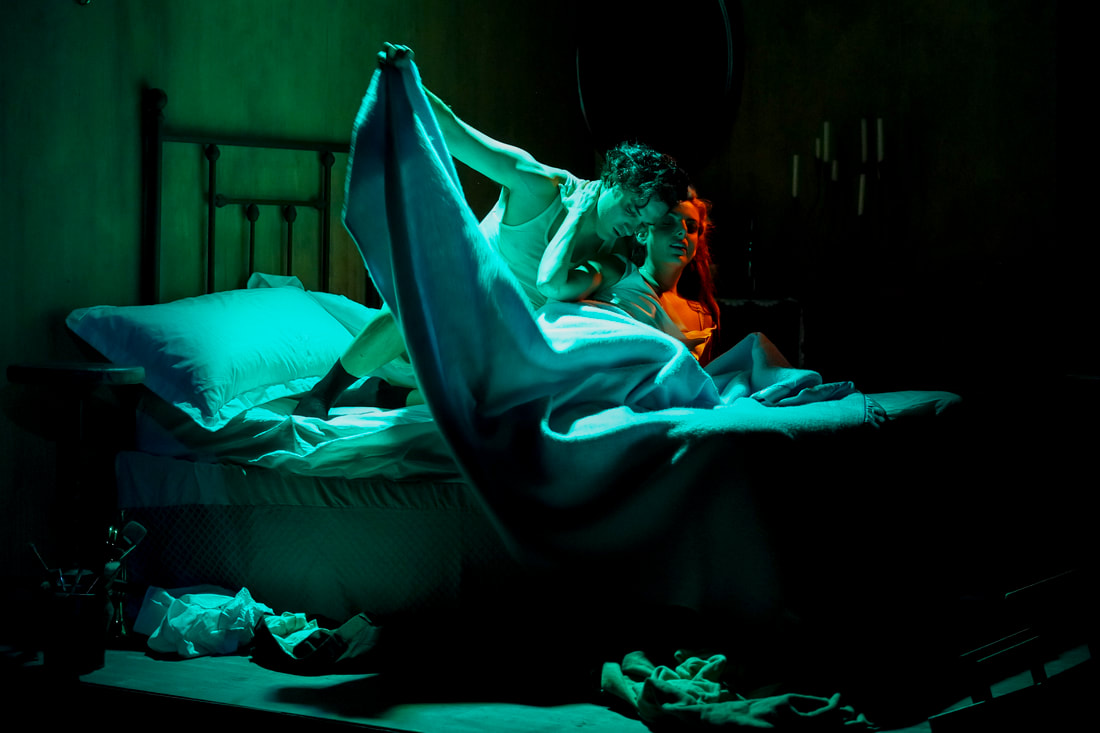|
Jose Balistrieri and Claire Kaplan in "Blue Period." Photo by Daren Scott It’s not unusual for artists of any medium to produce with prolificacy during a dark time in their lives. Such was the case with Pablo Picasso, whose melancholy work between 1901 to 1904 is considered his Blue Period. Anyone with even basic knowledge of Picasso has heard of the Blue Period and is familiar with its most emblematic painting, “The Old Guitarist” from 1903. What they may not know was what plunged Picasso into this somber stage of his career.
The truth: an abiding but obsessive friendship, and more so the deterioration and loss of that friend. As dramatized in OnStage Playhouse’s world-premiere play "Blue Period," by Charles Borkhuis, a young Picasso’s best friend in Paris, Carles Casamegas, consumed his energies practically as much as his paintings. While the 19-year-old Picasso (Javier Guerrero) worked to establish himself in an art society where Matisse and Renoir reigned, his devoted yet troubled companion, Casamegas (Jose Balistrieri), teetered back and forth on the edge of self-destruction. An in-his-mind failed artist himself, Casamegas also suffered from twin addictions: one to morphine, the other to Picasso’s ravishing model, Germaine (Claire Kaplan). As the play directed by James Darvas opens, Casamegas is in high spirits in every sense of the word, prancing about in a mask (no symbolism there, right?) while his friend works on a portrait of a scarcely clothed Germaine. It is the most ebullient we will see Casamegas over the ensuing two hours as very soon it becomes apparent that he has little control over his demons or his emotions. If it were 2022 instead of 1900 he’d be classified as dangerously manic-depressive. Because the character’s wild instability is so theatrical, Balistrieri overshadows Guerrero’s by-comparison-restrained Picasso, not to mention Kaplan or Herbert Siguenza as leering art dealer Pere Manyac, in Act One of “Blue Period.” Act Two is a very different proposition, with the focus turned to Picasso, his depression and guilt, and how they compel him into tortured years of driven work that will ultimately alienate both Germaine, who loves him, and Manyac, who’s been acting as his agent. What you have is almost two separate plays on stage – one playful then histrionic, the other as muted as the paintings of Picasso’s Blue Period. It’s not an easy narrative transition. The performances at OnStage help, though Guerrero never fully affects the degree of charisma that is associated with Picasso. Balistrieri owns the showcase part. His Casamegas is brokedown, nearly out of control. The multitalented Siguenza, whose one-man show “A Weekend with Pablo Picasso” is as departed from “Blue Period” as could be, is underutilized in a relatively straight role. He is due some credit, however, for bringing this promising play to the attention of Darvis, who is OnStage’s artistic director. Kaplan is magical as the model Germaine, in her way in love with Picasso, Casamegas and her husband in an open marriage. She is so beautiful and brimming with life that the resulting contrast with the brooding Picasso of Act Two is all the more dramatic. Here and there “Blue Period” could stand a bit of trimming, but it’s a frequently inspiring mingling of art history and psychology. All that and Paris too. “Blue Period” runs through Aug. 7 at OnStage Playhouse in Chula Vista.
0 Comments
Leave a Reply. |
AuthorDavid L. Coddon is a Southern California theater critic. Archives
July 2024
Categories |
David Coddon |
|
